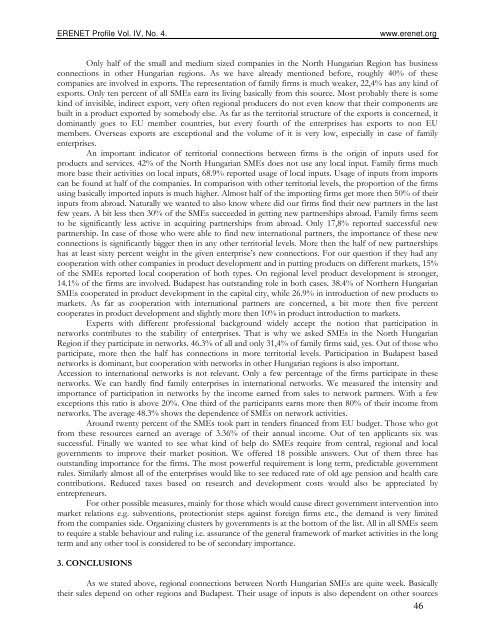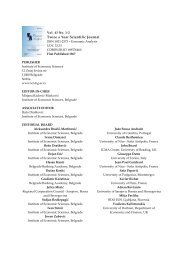Issue 16
Issue 16
Issue 16
Create successful ePaper yourself
Turn your PDF publications into a flip-book with our unique Google optimized e-Paper software.
ERENET Profile Vol. IV, No. 4.<br />
www.erenet.org<br />
Only half of the small and medium sized companies in the North Hungarian Region has business<br />
connections in other Hungarian regions. As we have already mentioned before, roughly 40% of these<br />
companies are involved in exports. The representation of family firms is much weaker, 22,4% has any kind of<br />
exports. Only ten percent of all SMEs earn its living basically from this source. Most probably there is some<br />
kind of invisible, indirect export, very often regional producers do not even know that their components are<br />
built in a product exported by somebody else. As far as the territorial structure of the exports is concerned, it<br />
dominantly goes to EU member countries, but every fourth of the enterprises has exports to non EU<br />
members. Overseas exports are exceptional and the volume of it is very low, especially in case of family<br />
enterprises.<br />
An important indicator of territorial connections between firms is the origin of inputs used for<br />
products and services. 42% of the North Hungarian SMEs does not use any local input. Family firms much<br />
more base their activities on local inputs, 68.9% reported usage of local inputs. Usage of inputs from imports<br />
can be found at half of the companies. In comparison with other territorial levels, the proportion of the firms<br />
using basically imported inputs is much higher. Almost half of the importing firms get more then 50% of their<br />
inputs from abroad. Naturally we wanted to also know where did our firms find their new partners in the last<br />
few years. A bit less then 30% of the SMEs succeeded in getting new partnerships abroad. Family firms seem<br />
to be significantly less active in acquiring partnerships from abroad. Only 17,8% reported successful new<br />
partnership. In case of those who were able to find new international partners, the importance of these new<br />
connections is significantly bigger then in any other territorial levels. More then the half of new partnerships<br />
has at least sixty percent weight in the given enterprise’s new connections. For our question if they had any<br />
cooperation with other companies in product development and in putting products on different markets, 15%<br />
of the SMEs reported local cooperation of both types. On regional level product development is stronger,<br />
14.1% of the firms are involved. Budapest has outstanding role in both cases. 38.4% of Northern Hungarian<br />
SMEs cooperated in product development in the capital city, while 26.9% in introduction of new products to<br />
markets. As far as cooperation with international partners are concerned, a bit more then five percent<br />
cooperates in product development and slightly more then 10% in product introduction to markets.<br />
Experts with different professional background widely accept the notion that participation in<br />
networks contributes to the stability of enterprises. That is why we asked SMEs in the North Hungarian<br />
Region if they participate in networks. 46.3% of all and only 31,4% of family firms said, yes. Out of those who<br />
participate, more then the half has connections in more territorial levels. Participation in Budapest based<br />
networks is dominant, but cooperation with networks in other Hungarian regions is also important.<br />
Accession to international networks is not relevant. Only a few percentage of the firms participate in these<br />
networks. We can hardly find family enterprises in international networks. We measured the intensity and<br />
importance of participation in networks by the income earned from sales to network partners. With a few<br />
exceptions this ratio is above 20%. One third of the participants earns more then 80% of their income from<br />
networks. The average 48.3% shows the dependence of SMEs on network activities.<br />
Around twenty percent of the SMEs took part in tenders financed from EU budget. Those who got<br />
from these resources earned an average of 3.36% of their annual income. Out of ten applicants six was<br />
successful. Finally we wanted to see what kind of help do SMEs require from central, regional and local<br />
governments to improve their market position. We offered 18 possible answers. Out of them three has<br />
outstanding importance for the firms. The most powerful requirement is long term, predictable government<br />
rules. Similarly almost all of the enterprises would like to see reduced rate of old age pension and health care<br />
contributions. Reduced taxes based on research and development costs would also be appreciated by<br />
entrepreneurs.<br />
For other possible measures, mainly for those which would cause direct government intervention into<br />
market relations e.g. subventions, protectionist steps against foreign firms etc., the demand is very limited<br />
from the companies side. Organizing clusters by governments is at the bottom of the list. All in all SMEs seem<br />
to require a stable behaviour and ruling i.e. assurance of the general framework of market activities in the long<br />
term and any other tool is considered to be of secondary importance.<br />
3. CONCLUSIONS<br />
As we stated above, regional connections between North Hungarian SMEs are quite week. Basically<br />
their sales depend on other regions and Budapest. Their usage of inputs is also dependent on other sources<br />
46
















